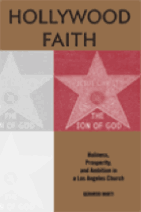My co-author Gladys Ganiel and I have been working diligently to craft the final contours of our forthcoming book The Deconstructed Church — a book oriented toward describing the identity and practices of "Emerging Christians." While the draft is not complete, it looks like we're on target to turn in the manuscript this summer.
A lot of writing exists (and much more since we received the contract with Oxford University Press) about the Emerging Church Movement—mostly a mixture of suppositions, speculations, and various spokespeople representing their visions for the movement. But sociologists of religion have been reluctant to pay much attention to this group of network-dependent, loosely-affiliated, and largely marginalized "Christians." There are insiders and critics who are sick to death of hearing about emerging/emergent Christians, while there are plenty of outsiders who are still discovering it, intrigued by the orientation, and struggling to figure it out.
And there are a few scholars of religion who have found enough permanence among these groups (existing since the late 1990s, with and without the label) that one esteemed colleague said to me that she's heard of several people who are trying to stake some kind of scholarly "claim" to understanding the movement.
Like a lot of researchers, I follow my nose: meaning, I have a set of questions that intrigue me, a set of observations that coalesce at various times, and moments of opportunity to investigate things that serve to highlight important aspects about identity, social change, and the often surprising dynamics that govern our lives.
I have zero interest in staking any exclusive claim to understanding the Emerging Church Movement. I've spoken about it at academic conferences and written about it. Occasionally, I've been interviewed by a reporter. But there are others. Gladys certainly has her expertise. Other social scientists have recently published some insightful analyses (James Bielo's Emerging Evangelicals and Josh Packard's The Emerging Church come to mind). What I am interested in doing is taking a fairly extensive data set that combines my interviews/observations with Gladys', and supplementing those with data gathered originally by Tony Jones for his dissertation in Practical Theology at Princeton (you can find it on Amazon). Although Tony has published his thoughts, I have avoided reading this work closely as Gladys and my goal has been to systematically analyze the whole of the data and inductively assess the patterns that (ahem) "emerge."
I'm very pleased with our work so far. I think our book holds some surprises—even for those who are long time observers and insiders. We bring our own conceptual lenses to bear to what has become an impossibly ambitious task: How do we frame the workings of a diffuse religious orientation against the backdrop of the changed society that makes it possible? The Emerging Church Movement would not have existed 100 years ago, even 50 years ago. It is a manifestation of shifting ground for what it means to be religious today, and what the possibilities for congregational life are in the near future.
As a book-length analysis, it strains a blog post to summarize our findings. You'll forgive me that I won't even try. But I am excited enough to say "Stay Tuned," this book will be worth the wait. Expected sometime Fall 2014.
Tuesday, April 9, 2013
Subscribe to:
Post Comments (Atom)



No comments:
Post a Comment